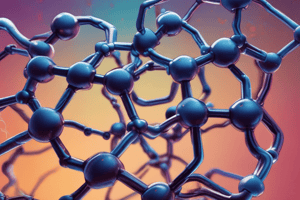Podcast
Questions and Answers
What is the general formula for alkenes?
What is the general formula for alkenes?
CnH2n
What type of bond is formed in alkenes?
What type of bond is formed in alkenes?
- One sigma bond and one pi bond (correct)
- Only sigma bonds
- No bonds
- Only pi bonds
What geometry do carbon atoms in a double bond (C=C) possess?
What geometry do carbon atoms in a double bond (C=C) possess?
Trigonal planar
Cis isomers have groups on opposite sides of the double carbon bond.
Cis isomers have groups on opposite sides of the double carbon bond.
Alkenes can undergo addition reactions due to their pi bonds.
Alkenes can undergo addition reactions due to their pi bonds.
What must alkenes contain for E/Z isomerism to occur?
What must alkenes contain for E/Z isomerism to occur?
What is an electrophile?
What is an electrophile?
The double carbon bond is much ___ than single carbon bonds.
The double carbon bond is much ___ than single carbon bonds.
Match the following types of isomers to their description:
Match the following types of isomers to their description:
Flashcards are hidden until you start studying
Study Notes
Properties of Alkenes
- General formula for alkenes: CnH2n.
- Alkenes are unsaturated molecules due to the presence of at least one double carbon bond (C=C).
- The double bond consists of one sigma bond and one pi bond:
- Sigma bonds result from head-on overlap of s orbitals.
- Pi bonds arise from sideways overlap of p orbitals, creating two regions of electron density.
- Alkenes exhibit trigonal planar geometry around the double bond with a bond angle of 120°.
- The spatial arrangement minimizes repulsion among the three bonding pairs.
Stereoisomerism
- Stereoisomers have the same structural formula but differ in atom arrangements in space.
- Alkenes can form cis/trans or E/Z isomers due to restricted rotation around the C=C bond.
- Cis isomers: Similar groups are on the same side of the double bond.
- Trans isomers: Similar groups are on opposite sides of the double bond.
- E/Z isomer labeling involves assigning priority based on molecular mass:
- Higher molecular mass groups get higher priority.
- Z isomers have high-priority groups on the same side; E isomers have them on opposite sides.
- Conditions for E/Z isomerism:
- Presence of a double carbon bond (restricting rotation).
- Each carbon of the C=C bond must be attached to two different groups.
Addition Reactions
- Alkenes are more reactive than alkanes due to the high electron density of the pi bond and weaker double bond strength.
- Addition reactions break the double bond, allowing other atoms to bond with carbon atoms, achieving 100% atom economy (one product formed).
- Hydrogenation: Hydrogen reacts with alkenes to form alkanes, requiring a nickel catalyst and a temperature of 150°C.
- Halogenation: Alkenes react with halogens at room temperature and pressure to produce halogenoalkanes via an electrophilic addition mechanism.
Mechanism of Halogenation
- The pi electrons in the C=C bond create a negative region that repels electrons in the halogen bond:
- This forms an induced dipole in the halogen molecule.
- The pi electrons attack the positively charged halogen atom, resulting in bond formation.
- The halogen bond undergoes heterolytic fission, creating a negative halide ion.
- The carbon atom may become positively charged (carbocation intermediate) after bond formation.
- The negative halide ion then bonds covalently with the positive carbon to yield a dihalogenoalkane.
- Electrophiles (such as halogens) are species that accept a pair of electrons and play a key role in addition reactions.
- Reaction with bromine water serves as a test for unsaturation: unreacted bromine is orange, while formation of halogenoalkane turns it colorless.
Studying That Suits You
Use AI to generate personalized quizzes and flashcards to suit your learning preferences.




